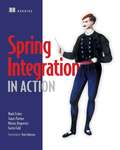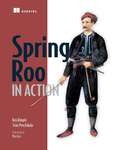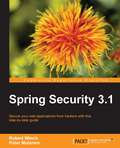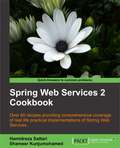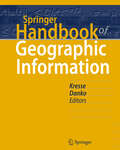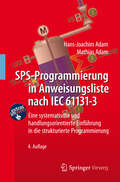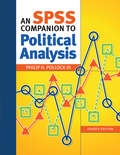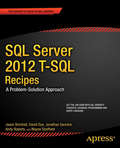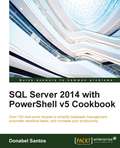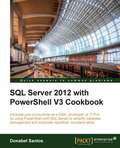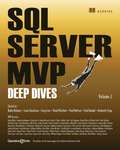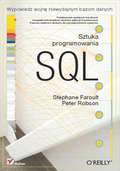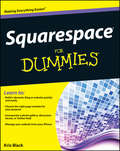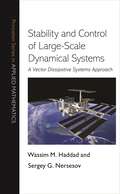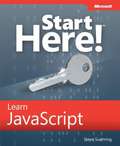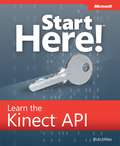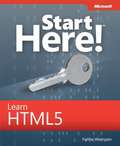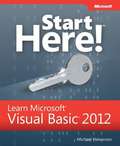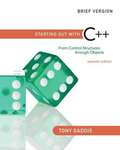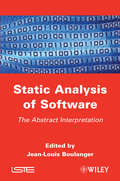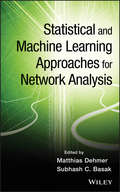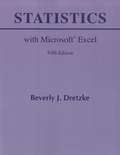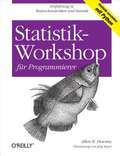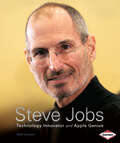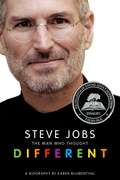- Table View
- List View
Spring Integration in Action
by Iwein Fuld Jonas Partner Mark Fisher Marius BogoeviciSummarySpring Integration in Action is a hands-on guide to Spring-based messaging and integration. After addressing the core messaging patterns, such as those used in transformation and routing, the book turns to the adapters that enable integration with external systems. Readers will explore real-world enterprise integration scenarios using JMS, Web Services, file systems, and email. They will also learn about Spring Integration's support for working with XML. The book concludes with a practical guide to advanced topics such as concurrency, performance, system-management, and monitoring.The book features a foreword by Rod Johnson, Founder of the Spring Network.About the TechnologySpring Integration extends the Spring Framework to support the patterns described in Gregor Hohpe and Bobby Woolf's Enterprise Integration Patterns. Like the Spring Framework itself, it focuses on developer productivity, making it easier to build, test, and maintain enterprise integration solutions.About the BookSpring Integration in Action is an introduction and guide to enterprise integration and messaging using the Spring Integration framework. The book starts off by reviewing core messaging patterns, such as those used in transformation and routing. It then drills down into real-world enterprise integration scenarios using JMS, Web Services, filesystems, email, and more. You'll find an emphasis on testing, along with practical coverage of topics like concurrency, scheduling, system management, and monitoring.This book is accessible to developers who know Java. Experience with Spring and EIP is helpful but not assumed. Purchase of the print book comes with an offer of a free PDF, ePub, and Kindle eBook from Manning. Also available is all code from the book. What's InsideRealistic examplesExpert advice from Spring Integration creatorsDetailed coverage of Spring Integration 2 featuresAbout the AuthorsMark Fisher is the Spring Integration founder and project lead. Jonas Partner, Marius Bogoevici, and Iwein Fuld have all been project committers and are recognized experts on Spring and Spring Integration.Table of ContentsPART 1 BACKGROUNDIntroduction to Spring IntegrationEnterprise integration fundamentals 24PART 2 MESSAGINGMessages and channelsMessage EndpointsGetting down to businessGo beyond sequential processing: routing and filteringSplitting and aggregating messagesPART 3 INTEGRATING SYSTEMSHandling messages with XML payloadsSpring Integration and the Java Message ServiceEmail-based integrationFilesystem integrationSpring Integration and web servicesChatting and tweetingPART 4 ADVANCED TOPICSMonitoring and managementManaging scheduling and concurrencyBatch applications and enterprise integrationScaling messaging applications with OSGiTesting
Spring Roo in Action
by Ken Rimple Srini PenchikalaSummarySpring Roo in Action is a unique book that teaches you how to code Java in Roo, with a particular focus on Spring-based applications. Through hands-on examples, you'll learn how Roo creates well-formed application structures and supports best practices and tools. Plus, you'll get a quick-and-dirty guide to setting up Roo effectively in your environment.About the TechnologyRoo is a lightweight Java console shell that simplifies compile-time tasks. It improves productivity by enforcing correct coding practices and patterns and integrates with mainstream Java technologies, including ActiveMQ, GWT, JPA, and OSGi. And, when you finish coding, it gets out of the way so there's no runtime impact.About the BookSpring Roo in Action teaches you to code Java more efficiently using Roo. With the help of many examples, it shows you how to build application components from the database layer to the user interface. The book takes a test-first approach and points out how Roo can help automate many of the mundane details of coding Java apps. Along the way, you'll address important topics like security, messaging, and cloud computing.This book is for Java developers who want to get more productive by using Roo. Purchase of the print book comes with an offer of a free PDF, ePub, and Kindle eBook from Manning. Also available is all code from the book. What's InsideLearn Roo from the ground upIntegrate with existing projectsCreate custom add-onsUse Roo with Spring======================================================Table of ContentsPART 1 STARTING SPRING APPS RAPIDLY WITH ROOWhat is Spring Roo?Getting started with RooPART 2 DATABASES AND ENTITIESDatabase persistence with entitiesRelationships, JPA, and advanced persistencePART 3 WEB DEVELOPMENTRapid web applications with RooAdvanced web applicationsRIA and other web frameworksConfiguring securityPART 4 INTEGRATIONTesting your applicationEnterprise services—email and messagingRoo add-onsAdvanced add-ons and deploymentPART 5 ROO IN THE CLOUDCloud computingWorkflow applications using Spring Integration
Spring Security 3.1
by Robert WinchThis practical step-by-step tutorial has plenty of example code coupled with the necessary screenshots and clear narration so that grasping content is made easier and quicker,This book is intended for Java web developers and assumes a basic understanding of creating Java web applications, XML, and the Spring Framework. You are not assumed to have any previous experience with Spring Security.
Spring Web Services 2 Cookbook
by Hamidreza Sattari Shameer KunjumohamedThis is a cookbook full of recipes with the essential code explained clearly and comprehensively. Each chapter is neatly compartmentalized with focused recipes which are perfectly organized for easy reference and understanding. This book is for Java/J2EE developers. As the books covers a variety of topics in Web-Service development, it will serve as a reference guide to those already familiar with Web-Services. Beginners can also use this book to gain real-world experience of Web-Service development.
Springer Handbook of Geographic Information
by Wolfgang Kresse David M. DankoComputer science provides a powerful tool that was virtually unknown three generations ago. Some of the classical fields of knowledge are geodesy (surveying), cartography, and geography. Electronics have revolutionized geodetic methods. Cartography has faced the dominance of the computer that results in simplified cartographic products. All three fields make use of basic components such as the Internet and databases. The Springer Handbook of Geographic Information is organized in three parts, Basics, Geographic Information and Applications. Some parts of the basics belong to the larger field of computer science. However, the reader gets a comprehensive view on geographic information because the topics selected from computer science have a close relation to geographic information. The Springer Handbook of Geographic Information is written for scientists at universities and industry as well as advanced and PhD students.
SPS-Programmierung in Anweisungsliste nach IEC 61131-3: Eine systematische und handlungsorientierte Einführung in die strukturierte Programmierung
by Hans-Joachim Adam Mathias AdamDas Lehr- und Übungsbuch vermittelt solides Grundwissen und umfassende praktische Fähigkeiten bei der SPS-Programmierung. Im Anschluss an vier Kapitel, die die verschiedenen Zahlensysteme sowie die Digitaltechnik behandeln, folgen Programmierbeispiele: Schaltnetze, Signalspeicher, Zeitfunktionen, Zähler, Funktionsbausteine und Funktionen, Programmstrukturen, Ablaufsteuerungen u. a. Mit der im Internet bereitgestellten Simulationssoftware und den Musterlösungen können Leser das erworbene Wissen direkt anwenden.
An SPSS Companion to Political Analysis
by Philip H. PollockIn this much-anticipated revision of Pollock's popular SPSS workbook, students dive headfirst into actual political data and work with a software tool that prepares them for future political science research. Students learn by doing with guided examples, more than 120 screenshots, and step-bystep instructions.
SQL Server 2012 T-SQL Recipes
by Jason Brimhall David Dye Jonathan Gennick Andy Roberts Wayne SheffieldSQL Server 2012 T-SQL Recipes is an example-based guide to the Transact-SQL language that is at the core of SQL Server 2012. It provides ready-to-implement solutions to common programming and database administration tasks. Learn to create databases, insert and update data, generate reports, secure your data, and more. Tasks and their solutions are broken down into a problem/solution format that is quick and easy to read so that you can get the job done fast when the pressure is on. Solutions in this book are divided into chapters by problem domain. Each chapter is a collection of solutions around a single facet of the language such as writing queries, developing triggers, and applying aggregate functions. Each solution is presented code-first, giving you a working code example to copy from and implement immediately in your own environment. Following each example is an in-depth description of how and why the given solution works. Tradeoffs and alternative approaches are also discussed. Focused on solutions: Look up what you need to do. Learn how to do it. Do it. Current: Newly updated for SQL Server 2012 Comprehensive: Covers all common T-SQL problem domains What you'll learn Create databases, tables, and indexes Query and manipulate data Store and manage XML inside the database Move business logic into the database Resolve common performance problems. Build reports that matter to your business. Perform common backup and recovery tasks. Who this book is for SQL Server 2012 T-SQL Recipes is aimed at technically-oriented users of SQL Server desiring to extract the full power of the platform through it's powerful, built-in programming and scripting language. Target readers include developers who use Microsoft SQL Server 2012 as their backend database, and the database administrators who create, manage, and secure those databases. Table of Contents Getting Started with SELECT Elementary Programming Nulls and Other Pitfalls Combining Data from Multiple Tables Grouping and Summarizing Advanced SELECT Techniques Query Techniques for Reporting Inserting, Updating, Deleting Working with Strings Working with Dates Working with Numbers Transactions, Locking, Blocking, Deadlocking Managing Tables Managing Views Managing Indexes Managing Large Tables Stored Procedures User-Defined Functions Triggers Error Handling Query Performance Hints Index Tuning and Statistics XML Files, Filegroups, and Integrity Backup Recovery Principals and Users Securables and Permissions Objects and Dependencies "
SQL Server 2012 with PowerShell V3 Cookbook
by Donabel SantosSQL Server 2012 with PowerShell V3 Cookbook" is an example-focused book that provides step-by-step instructions on how to accomplish specific SQL Server tasks using PowerShell. Each recipe is followed by an analysis of the steps or design decisions taken, and additional information about the task at hand. Working scripts are provided for all examples so that you can dive in right away. You can read this book sequentially by chapter, or you can pick and choose which topics you need right away,This book is written for the SQL Server database professional (DBA, developer, BI developer) who wants to use PowerShell to automate, integrate, and simplify database tasks. A little bit of scripting background is helpful, but not necessary.
SQL Server 2012 with PowerShell V3 Cookbook
by Donabel Santos"SQL Server 2012 with PowerShell V3 Cookbook" is an example-focused book that provides step-by-step instructions on how to accomplish specific SQL Server tasks using PowerShell. Each recipe is followed by an analysis of the steps or design decisions taken, and additional information about the task at hand. Working scripts are provided for all examples so that you can dive in right away. You can read this book sequentially by chapter, or you can pick and choose which topics you need right away,This book is written for the SQL Server database professional (DBA, developer, BI developer) who wants to use PowerShell to automate, integrate, and simplify database tasks. A little bit of scripting background is helpful, but not necessary.
SQL Server MVP Deep Dives, Volume 2
by Paul S. Randal Kimberly Tripp Paul Nielsen Kalen DelaneySummary SQL Server MVP Deep Dives, Volume 2 is a unique book that lets you learn from the best in the business - 64 SQL Server MVPs offer completely new content in this second volume on topics ranging from testing and policy management to integration services, reporting, and performance optimization techniques...and more. About this Book To become an MVP requires deep knowledge and impressive skill. Together, the 64 MVPs who wrote this book bring about 1,000 years of experience in SQL Server administration, development, training, and design. This incredible book captures their expertise and passion in 60 concise, hand-picked chapters and offers valuable insights for readers of all levels. SQL Server MVP Deep Dives, Volume 2 picks up where the first volume leaves off, with completely new content on topics ranging from testing and policy management to integration services, reporting, and performance optimization. The chapters fall into five parts: Architecture and Design, Database Administration, Database Development, Performance Tuning and Optimization, and Business Intelligence. Purchase of the print book comes with an offer of a free PDF, ePub, and Kindle eBook from Manning. Also available is all code from the book. What's Inside Discovering servers with PowerShell Using regular expressions in SSMS Tuning the Transaction Log for OLTP Optimizing SSIS for dimensional data Real-time BI and much more Manning Publications and the authors of this book support the children of Operation Smile, an international children's medical charity that performs free reconstructive surgery for children suffering from facial deformities such as cleft lips and cleft palates by mobilizing medical volunteers who provide education and training programs to local doctors on the latest surgical techniques. =============================================== Table of Contents PART 1 ARCHITECTURE Edited by Louis Davidson PART 2 DATABASE ADMINISTRATION Edited by Paul Randal and Kimberly Tripp PART 3 DATABASE DEVELOPMENT Edited by Paul Nielsen PART 4 PERFORMANCE TUNING AND OPTIMIZATION Edited by Brad M. McGehee PART 5 BUSINESS INTELLIGENCE Edited by Greg Low
SQL. Sztuka programowania
by Peter Robson Stephane FaroultWypowiedz wojn? niewydajnym bazom danych Projektowanie wydajnych baz danych Uwzgl?dnianie kontekstu dzia?ania aplikacji bazodanowych Poprawa szybko?ci dzia?ania ?le zaprojektowanych systemów Twoje bazy danych dzia?aj? zbyt wolno? Pora to zmieni?! Wraz ze wzrostem wielko?ci korporacyjnych baz danych czas dost?pu do nich ma coraz wi?ksze znaczenie. Napisanie poprawnie dzia?aj?cego kodu w j?zyku SQL nie jest trudne, jednak tworzenie wydajnych aplikacji bazodanowych jest prawdziw? sztuk?. Jak mo?esz zg??bi? jej tajniki i sta? si? lepszym programist?? Zdaniem autora tej ksi??ki nauka wydajnej pracy z bazami danych przypomina poznawanie zasad prowadzenia wojny, dlatego wzorem klasycznej pozycji "Sztuka wojny" autorstwa Sun Tzu prowadzi Ci? on przez poszczególne etapy kampanii przeciwko nieefektywnie zaprojektowanym i napisanym aplikacjom bazodanowym. "SQL. Sztuka programowania" to praktyczny podr?cznik, dzi?ki któremu szybko poszerzysz sw? wiedz? w zakresie efektywnego stosowania j?zyka SQL. Nauczysz si? dba? o wydajno?? aplikacji ju? na etapie ich projektowania, a tak?e my?le? o pracy z bazami danych w kategoriach procesów, wykraczaj?c poza same zapytania j?zyka SQL. Dowiesz si?, jak poprawnie u?ywa? indeksów oraz jak monitorowa? szybko?? dzia?ania bazy. Poznasz standardowe scenariusze zwi?kszania wydajno?ci, które pozwol? Ci zastosowa? sprawdzone fortele we w?asnych projektach oraz w bazach zaprojektowanych przez innych programistów. Projektowanie pod k?tem wydajno?ci Efektywne korzystanie z baz danych w programach Poprawne stosowanie indeksów Projektowanie optymalnych zapyta? SQL Praca z du?ymi zbiorami danych Korzystanie ze struktur drzewiastych Monitorowanie wydajno?ci Obs?uga wspó?bie?no?ci Radzenie sobie z niewydajnymi projektami Poznaj praktyczne techniki poprawy wydajno?ci baz danych.
Squarespace For Dummies
by Josh Kill Kris BlackDiscover how to build your own blog, website, or portfolio with Squarespace! Squarespace is a fast-growing all-in-one solution for creating and maintaining a blog, website, or portfolio that allows you to drag and drop various site elements and manage your finished product on the free Squarespace iPhone application. In this fun and friendly 224-page ebook, Squarespace For Dummies helps you discover the variety of modules to choose from, including blogs, maps, social network integration, HTML code blocks, photo galleries, and more. Packed with valuable information on how to maximize your website and the visitor experience, this guide offers tips for installing widgets, adding new widgets from third parties, and customization instructions. The author explains how Squarespace offers you the ability to use real-time visitor analytics, page rank tracking, and more. Examines the possibilities and potential of Squarespace, a publishing platform for building and maintaining a website Zeroes in on the various modules that you can choose from, including blogs, social network integration, photo galleries, and more Includes advice for getting the most out of your Squarespace website Squarespace For Dummies will get you started building your own website in no time!
Stability and Control of Large-Scale Dynamical Systems: A Vector Dissipative Systems Approach (Princeton Series in Applied Mathematics #41)
by Wassim M. Haddad Sergey G. NersesovModern complex large-scale dynamical systems exist in virtually every aspect of science and engineering, and are associated with a wide variety of physical, technological, environmental, and social phenomena, including aerospace, power, communications, and network systems, to name just a few. This book develops a general stability analysis and control design framework for nonlinear large-scale interconnected dynamical systems, and presents the most complete treatment on vector Lyapunov function methods, vector dissipativity theory, and decentralized control architectures. Large-scale dynamical systems are strongly interconnected and consist of interacting subsystems exchanging matter, energy, or information with the environment. The sheer size, or dimensionality, of these systems necessitates decentralized analysis and control system synthesis methods for their analysis and design. Written in a theorem-proof format with examples to illustrate new concepts, this book addresses continuous-time, discrete-time, and hybrid large-scale systems. It develops finite-time stability and finite-time decentralized stabilization, thermodynamic modeling, maximum entropy control, and energy-based decentralized control. This book will interest applied mathematicians, dynamical systems theorists, control theorists, and engineers, and anyone seeking a fundamental and comprehensive understanding of large-scale interconnected dynamical systems and control.
Start Here!™ Learn JavaScript
by Steve SuehringReady to learn JavaScript? Start Here! Learn the fundamentals of modern programming with JavaScript--and begin building your first apps for the web. If you have no previous experience with JavaScript, no problem--simply start here! This book introduces must-know concepts and techniques through easy-to-follow explanations, examples, and exercises. Here's where you start learning JavaScript Learn the basics of JavaScript programming Find out how to access browser content from JavaScript Manage images and validate form entries Retrieve data using the JavaScript Object Notation (JSON) Use JavaScript and HTML5 in Windows 8 applications Put it all together by creating your first programs
Start Here!™ Learn the Kinect™ API
by Rob MilesReady to learn Kinect programming? Start Here!TM Learn the fundamentals of programming with the KinectTM API--and begin building apps that use motion tracking, voice recognition, and more. If you have experience programming with C#--simply start here! This book introduces must-know concepts and techniques through easy-to-follow explanations, examples, and exercises. Here's where you start learning Kinect Build an application to display Kinect video on your PC Have Kinect take photographs when it detects movement Draw on a computer screen by moving your finger in the air Track your body gestures and use them to control a program Make a program that understands your speech and talks back to you Play a part in your own augmented reality game Create an "air piano" using Kinect with a MIDI device
Start Here!TM Learn HTML5
by Faithe Wempen<p>Learn the fundamentals of programming with HTML5—and begin building your first standards-based web pages from the ground up. If you have absolutely no previous experience, no problem—simply start here! This book introduces must-know concepts and getting-started techniques through easy-to-follow explanations, examples, and exercises.</p>
Start Here!TM Learn Microsoft Visual Basic® 2012
by Michael Halvorson<p>Learn the fundamentals of modern programming with Microsoft® Visual Basic® 2012—and begin building your first Windows 8 apps for the desktop. If you have absolutely no previous experience with Visual Basic, no problem—simply start here! This book introduces must-know concepts and techniques through easy-to-follow explanations, examples, and exercises.</p>
Starting Out with C++: From Control Structures through Objects (7th Edition, Brief Version)
by Tony GaddisThis edition covers the core programming concepts that are introduced in the first semester introductory programming course. The problem-solving approach inspires students while introducing the C++ programming language. The style of teaching builds programming confidence and enhances each student's development of programming skills. Clear and easy-to-read code listings, concise and practical real-world examples, and an abundance of exercises appear in every chapter.
Static Analysis of Software: The Abstract Interpretation (Wiley-iste Ser.)
by Jean-Louis BoulangerThe existing literature currently available to students and researchers is very general, covering only the formal techniques of static analysis. This book presents real examples of the formal techniques called "abstract interpretation" currently being used in various industrial fields: railway, aeronautics, space, automotive, etc. The purpose of this book is to present students and researchers, in a single book, with the wealth of experience of people who are intrinsically involved in the realization and evaluation of software-based safety critical systems. As the authors are people currently working within the industry, the usual problems of confidentiality, which can occur with other books, is not an issue and so makes it possible to supply new useful information (photos, architectural plans, real examples).
Statistical and Machine Learning Approaches for Network Analysis
by Subhash C. Basak Matthias DehmerExplore the multidisciplinary nature of complex networks through machine learning techniquesStatistical and Machine Learning Approaches for Network Analysis provides an accessible framework for structurally analyzing graphs by bringing together known and novel approaches on graph classes and graph measures for classification. By providing different approaches based on experimental data, the book uniquely sets itself apart from the current literature by exploring the application of machine learning techniques to various types of complex networks.Comprised of chapters written by internationally renowned researchers in the field of interdisciplinary network theory, the book presents current and classical methods to analyze networks statistically. Methods from machine learning, data mining, and information theory are strongly emphasized throughout. Real data sets are used to showcase the discussed methods and topics, which include:A survey of computational approaches to reconstruct and partition biological networksAn introduction to complex networks--measures, statistical properties, and modelsModeling for evolving biological networksThe structure of an evolving random bipartite graphDensity-based enumeration in structured dataHyponym extraction employing a weighted graph kernelStatistical and Machine Learning Approaches for Network Analysis is an excellent supplemental text for graduate-level, cross-disciplinary courses in applied discrete mathematics, bioinformatics, pattern recognition, and computer science. The book is also a valuable reference for researchers and practitioners in the fields of applied discrete mathematics, machine learning, data mining, and biostatistics.
Statistics With Microsoft Excel (Fifth Edition)
by Beverly DretzkeStatistics with Microsoft Excel, Fifth Edition, shows readers how to use Microsoft Excel® to perform statistical analysis. This step-by-step guide has been updated to cover the new features and interface of Excel 2010. Datasets and other resources (where applicable) for this book are available here.
Statistik-Workshop für Programmierer
by Allen B. DowneyWenn Sie programmieren können, beherrschen Sie bereits Techniken, um aus Daten Wissen zu extrahieren. Diese kompakte Einführung in die Statistik zeigt Ihnen, wie Sie rechnergestützt, anstatt auf mathematischem Weg Datenanalysen mit Python durchführen können. Praktischer Programmier-Workshop statt grauer Theorie: Das Buch führt Sie anhand eines durchgängigen Fallbeispiels durch eine vollständige Datenanalyse -- von der Datensammlung über die Berechnung statistischer Kennwerte und Identifikation von Mustern bis hin zum Testen statistischer Hypothesen. Gleichzeitig werden Sie mit statistischen Verteilungen, den Regeln der Wahrscheinlichkeitsrechnung, Visualisierungsmöglichkeiten und vielen anderen Arbeitstechniken und Konzepten vertraut gemacht. Statistik-Konzepte zum Ausprobieren: Entwickeln Sie über das Schreiben und Testen von Code ein Verständnis für die Grundlagen von Wahrscheinlichkeitsrechnung und Statistik: Überprüfen Sie das Verhalten statistischer Merkmale durch Zufallsexperimente, zum Beispiel indem Sie Stichproben aus unterschiedlichen Verteilungen ziehen. Nutzen Sie Simulationen, um Konzepte zu verstehen, die auf mathematischem Weg nur schwer zugänglich sind. Lernen Sie etwas über Themen, die in Einführungen üblicherweise nicht vermittelt werden, beispielsweise über die Bayessche Schätzung. Nutzen Sie Python zur Bereinigung und Aufbereitung von Rohdaten aus nahezu beliebigen Quellen. Beantworten Sie mit den Mitteln der Inferenzstatistik Fragestellungen zu realen Daten.
Steve Jobs: Technology Innovator and Apple Genius (Gateway Biographies Ser.)
by Matt DoedenOn October 5, 2011, the news of the death of technology innovator Steve Jobs rocked the world. The failing health of the Apple cofounder and Pixar CEO was no secret. Jobs had given up his role as Apple's CEO just a few months prior because of his struggle with pancreatic cancer. But his death still drew a huge reaction. From Apple employees and fans to political and business leaders, people honored Jobs's passing by reflecting on his prolific life that greatly influenced the way technology is used. In 1976, Jobs founded Apple Computer with Steve Wozniak. As the leaders of Apple, they developed concepts—such as navigating by using a mouse to click screen icons—that shaped the way we use and interact with computers. Jobs's forward-thinking engineering also influenced pop culture, bringing us a music revolution with the iPod, the ultimate communication device with the iPhone, and some of the first computer-animated films through Pixar. Called by some "the da Vinci of our time," Jobs used his innovation and vision to help advance technology like no other. He lived his life following a simple premise: "The only way to be truly satisfied is to do what you believe is great work. And the only way to do great work is to love what you do."
Steve Jobs: The Man Who Thought Different
by Karen BlumenthalThis is the story of Steve Jobs who changed our world. In this book, Karen Blumenthal takes us to the core of the complicated and legendary man while simultaneously exploring the evolution of computers.
